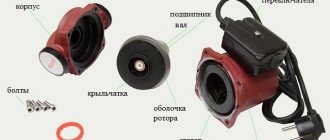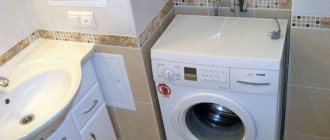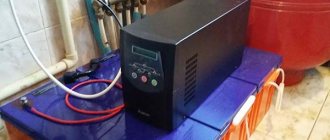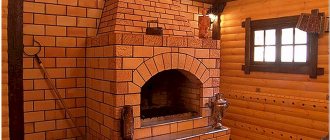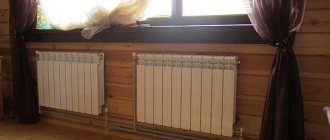Why install a circulation pump
If you are faced with problems of uneven heating of the heating system around the house, you can solve it in two ways:
- Replace all heating pipes by installing larger diameter pipes;
- Or install a circulation pump in the system.
Obviously, installing a circulation pump is much cheaper and more practical than replacing pipes. By installing a circulation pump into the system, you can solve several problems:
- The heating of heating devices will be more uniform;
- The heating system circuit will expand significantly;
- The pump will eliminate the problem of air locks.
The pump will make it easier to shower and use other plumbing fixtures at home at the same time. By the way, you can always buy cheap shower cabins. Moscow is full of surprises and the TM Titan online store is one of them.
It is worth noting that to install a circulation pump in a ready-made heating system, you do not have to do complex installation work. Insertion technology is used.
Features of circulation pumps
In systems with a forced circulation system, a pump is installed to increase heat capacity. Correct installation of the circulation pump in the heating system allows you to change the heat that is transferred depending on the outside temperature while maintaining stability of the heating in the room.
There are two types of such equipment : with a dry and wet rotor. Devices with a dry rotor have increased efficiency (about 80%), do not create much noise and require constant maintenance. The operation of a device with a wet rotor is different; it has a low efficiency (about 50%), is noisier, and its performance is sufficient to heat any private home.
30 years ago, homes used so-called vertical central heating, which was powered by liquid circulating through pipes, and the heat source was a gas boiler or wood-burning stove. Now there has been a transition to the construction of private housing using heaters with a pump, which has the following advantages:
- The coolant speed increases.
- The heat produced by the boiler is quickly delivered to the radiators and returned to its place.
- The heating process is significantly accelerated.
- The speed is higher, so the same amount of heat can be supplied to pipes with a smaller diameter. In other words, a pipe with forced circulation of water in a pump is cheaper. The barrel can now be wrapped with minimal deflection and added complexity. The main thing is to make the correct selection of the pump unit and set the pressure.
- An internal pump for circulating water in the heating system made it possible to have heated floors and efficient closed systems operating under high pressure.
- We managed to remove the pipes that run along the walls and do not always harmonize with the kitchen interior. Nowadays, heating lines are built into the walls, under the floor and behind the suspended ceiling.
As the main disadvantage of the pumps, it can be noted that if there is a need to frequently turn off the circulation pump, a generator must be installed or connected.
Selection (calculation) of a circulation pump
To select a circulation pump, you need to calculate its power. If you have a complex heating system, it is better to entrust the calculation of the pump to a specialist. In a simple heating system, the power of the required pump is calculated by the formula:
The calculation will allow you to select a pump according to the parameter: maximum water output or throughput.
Paying attention
Please note that for the circulation pump to operate, electricity must be available. The electrical power is not indicated on the pump labeling, but is 100-250 W, which allows you to connect them to any group of power outlets in the house. However, to protect against electric shock, the pump power line must be protected by a 30 mA RCD.
Important! When operating, circulation pumps produce a fairly strong “buzzing” sound. This parameter may be indicated in the pump descriptions and you need to pay attention to it; the smaller it is, the better.
Operating the circulation pump
It is necessary to follow some rules when operating the pump, including the following:
Automation for heating circulation pump
- The pump should not operate if there is no water in the heating system.
- The pump must not be allowed to operate at zero flow.
- A certain range of permissible flow rates must be observed during pump operation. The pump may fail if the water supply is too low or too high.
- If the pump is idle for quite a long period of time, then to prevent it you will need to turn it on at least once a month for 10-15 minutes. If this is not done, some pump components may oxidize.
- For normal operation of the pump, the temperature of the coolant in the heating system should not be higher than +65 degrees. This is necessary in order to prevent the precipitation of hard salts.
Temperature at the inlet and outlet of the circulation pump
- First, you need to make sure that there are no vibrations or noise from the heating pump.
- Check how the circulation pump works, based on its pressure-flow characteristics.
- Check to see if the electric pump motor is overheating.
- Check visually if there is a ground connection on the pump housing.
- Check if there are any leaks in the places where the pump is attached to the pipeline. If there is a slight leak, you will need to replace the gaskets or tighten the connecting components.
- Check how well the electrical wires in the terminal block are connected to each other.
Installing a circulation pump in a heating system
Material for work
Materials you will need:
- The pump itself;
- Connecting fittings for tapping the pump;
- Check valve or bypass valve;
- Two shut-off valves (ball valves) for installation on both sides of the pump;
- Coarse filter;
- Connecting coupling with lock nut;
- Plumbing winding and paste.
Tool for work
For work, prepare the following tool:
- Adjustable wrenches and wrenches of the required size;
- Welding.
Selecting a pump installation location
A modern “wet” type circulation pump can be installed in both the return and direct heating branches. Traditionally, the circulation pump is placed in the “return” in front of the boiler in order to:
- Reduce wear and increase the service life of the pump rotor;
- Avoid boiler boiling due to air being drawn out of the boiler by the pump;
- Damage to the pump due to possible boiling of the boiler, especially solid fuel.
Pump diagram in the forward pipeline and Pump diagram in the return pipeline
Operation and repair of the heating pump
The operating principle of the pump does not depend on the internal design. After the supply of electricity has been ensured, the drive motor shaft acts on the rotor and begins to rotate it. The liquid that enters the interior of the device is thrown back by centrifugal force and the impeller to the walls of the working chamber.
The coolant, which is influenced by centrifugal force, is gradually pushed into the discharge pipe.
Moreover, depending on the type of design, pumping stations can be classified into different types.
Working devices with a rotor are divided into:
- Dry;
- Wet.
Repairing the pump may require professional tools.
The latter are most often used to equip household heating systems; their rotor must be constantly in a liquid medium. This principle of operation contributes to effective cooling and lubrication of moving elements.
The advantages of this type include:
- Ease of maintenance, installation and repair;
- Low noise level during operation, since water is in all moving elements of the device.
The disadvantages of the devices include low efficiency and the possibility of installation only in a horizontal position, as well as the constant presence of liquid in the working system.
The operating principle of a dry rotor is that rotation is transmitted to the impeller from the electric motor shaft through a special coupling. Pumps of such devices have high efficiency, but have a more complex design, which can significantly complicate the repair and maintenance procedure. Such a pump is cut into the pipeline and mounted on the wall using special consoles.
Instructions for connecting the circulation pump
Note: There are two options for pump tapping: installing a shut-off valve or installing a ball valve on the main tapping line.
- When installing the pump in an existing heating network, first drain all the coolant;
- If necessary, clean the heating pipes;
- A bypass is installed at the pump installation site. The diameter of the bypass pipe must be made smaller than the diameter of the main pipe;
- We install a dirty filter in front of the pump. The filter has an arrow for water movement. It will stop the system sludge;
- The pump shaft must be installed horizontally. An arrow for coolant movement is shown on the pump body;
- Shut-off valves (ball valves) are installed before and after the pump. They play a technical role in case of repairs.;
- A shut-off valve or ball valve is placed on the main coolant pipe;
- When assembling, we adhere to the diagram;
- After installation of the pump is completed, the system is filled with coolant. Next, the pump screw is opened to bleed air (water will appear in the screw hole).
Important! The installation of the circulation pump is complete. If the heating system is shorter than 80 meters, then one circulation pump is sufficient.
Photo of vertical installation of a circulation pump with a ball valve
Photo of vertical installation of a pump with three valves
